Magnets: Where Physics Meets High Fashion
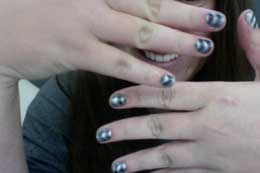
Photo courtesy of College Fashion
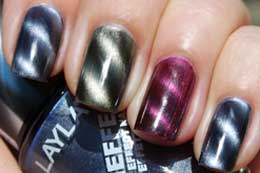
Photo courtesy of The Looks for Less
Showing off the effects of magnetic nail polish.
Physics enthusiasts aren't always the ones people turn to for advice on the latest fashion trends, this season's hottest color, or whether these shoes go with that outfit. However, it's impossible not to give physics at least partial credit for the recent nail craze--magnetic nail polish.
Magnetic nail polish is not some innovative way to pick up paperclips or keep track of nuts and bolts while doing chores around the house, although that type of nail polish might be useful in some situations. Magnetic nail polish refers to a traditional-looking polish that makes cool patterns if it dries in the presence of a magnet.
There are a few different kinds of magnetic nail polish, but in general you apply one coat of the polish and let it dry, and then apply a generous second coat one nail at a time. After applying the second coat of polish to a nail, you hold a magnet (often built into the lid of the bottle) directly over the polish for about 10 seconds and the pattern emerges.
Nails with these glossy, colorful patterns might not be commonplace in the laboratory, but change the context slightly and the patterns will be familiar to most physics students.
A little bit about magnets
Magnets play a visible role in everyday life, from sticking report cards to the refrigerator to sorting metal in a junkyard. But as visible as some magnets might be, the forces they exert on the objects around them are invisible. This short video clip is aimed at elementary school students, but it includes some fun demonstrations of magnetic force (and a superhero!).
Watch magnetic forces at work in Quick concepts presents magnets.
Recall that when it comes to magnets, opposites attract and likes repel. If you place the north pole of a bar magnet close to the south pole of another one, the two magnets will stick together. But if you place the north pole of a bar magnet close to the north pole of another bar magnet, the two will fight to keep from touching each other. What goes on inside of a magnet that makes this happen?
Scientists actually know less about this then you might expect. However, a simplified model is to think of every atom inside a metal as a tiny magnet, with a north and a south pole. In lots of materials these magnets are pointing in random directions, which mean that the material isn't magnetic. But in some materials, the majority of these little magnets are lined up with their north ends all pointing the same way and their south ends all pointing the same way--these are magnets.
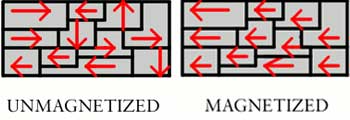
Copyright Explain that Stuff 2008, available under Creative Commons Attribution-Noncommercial-Share Alike license.
Iron is not naturally magnetic, but it isn't hard to turn it into a magnet. If you bring an iron nail close to the north end of a magnet, the south ends of the tiny magnets inside of the iron start to line up because they are attracted to the magnet, turning the iron into a magnet in the process. If the iron is close enough to the magnet, its magnetic force will pull the nail closer until the two magnets touch.
What does this have to do with nail polish?
A common way to visualize a magnetic field, which describes how a magnet affects nearby magnetic materials (and electric currents, but that's another story), is to sprinkle long, thin pieces of iron in the area around a magnet.

The pattern that emerges when iron filings are sprinkled around a bar magnet.
When you sprinkle these iron filings around a magnet, each of the filings becomes a small magnet, attracting and repelling the original magnet and all of the other pieces of iron. The filings are pushed and pulled by the forces until they settle into a pattern where the attractive and repulsive force balance. For a bar magnet, this is the result.
If you do the same thing with magnets of different shapes, or use multiple magnets, different patterns emerge.
The designs in magnetic nail polish are formed in the same way. Nail polish manufacturers mix iron powder in with the polish. The color of polish looks uniform when it is painted on, because at that point the iron is evenly distributed within the polish. However, when a magnet is placed near the polish, the bits of iron are attracted and repelled by the magnet and each other, and form a pattern just as the iron filings do in the lab. The pattern that appears on the nail depends entirely on the arrangement of magnets and where you place them above the nail. Of course nail polish is just one of the many applications of magnets, but it is one that is a lot of fashion fun!
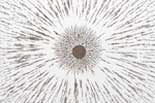 Iron filings magnetized by one end of a bar magnet. |
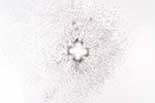 Iron filings magnetized by a cross shaped magnet. |
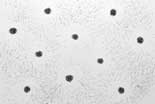 Iron filings magnetized by multiple round magnets. |
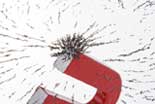 Iron filings magnetized by one end of a horseshoe magnet. |
| Images courtesy of Peter Mueller / mediacolor's, photographersdirect.com | |||
Watch magnetic polish in action in Sephora Presents nails inc. Magnetic Polish.
For more information, check out:
HowStuffWorks: How magnets work
Go here for a more in-depth discussion about what magnets are, how to make them, and why they stick.
eHow: Why does a magnet attract iron?
This video provides more detail on the properties of magnets and why a piece of iron becomes magnetic when you place it near a magnet.
Explain that Stuff! Magnetism
A good introduction to all things magnetic--magnets, magnetic fields, electromagnets, magnetic theory, and more.
HowMagnetsWork.com: Types of magnets
Why are magnets attracted to some things but not others? Visit this site to learn about different types of magnets, how they are used, and some of their history.
And while you're in magnet mode, check out these PhysicsCentral stories that highlight some of the coolest applications of magnets:
Ferrofluid Fun
Have you ever seen a liquid magnet? If magnetic material is ground into an extremely fine powder, with a particle size of about 10 nanometers, and suspended in a liquid, the resulting magnetic suspension is called a ferrofluid.
fMRI – The Future Mind Reader?
There have been claims that fMRI (functional magnetic resonance imaging) can determine if you are telling the truth, what image you are looking at, and perhaps in the future, what you are thinking , feeling, or intending.
Giant Magnetoresistance
Nobel-prize-winning research led to the MP3 player and HDTV-on-demand.
Magnets might prevent heart attacks
For people at risk of a heart attack or stroke, the common preventative treatment is to take aspirin or another blood-thinning medicine. Now two physicists have come up with a mechanical treatment that might offer an alternative.
MRI Magic
Medical x-rays provide images of the body but utilize radiation that in large doses can damage cells. A completely different technology, magnetic resonance imaging (MRI), emerged in the late 1970s.
Migration via quantum mechanics
A perplexing property of quantum mechanics could be allowing birds to see and navigate the planet’s magnetic fields.
Superconductors
How would you like to board a Maglev train and then speed off to your destination at more than 300 miles per hour? The magnets that levitate these trains are an application of superconductivity.














